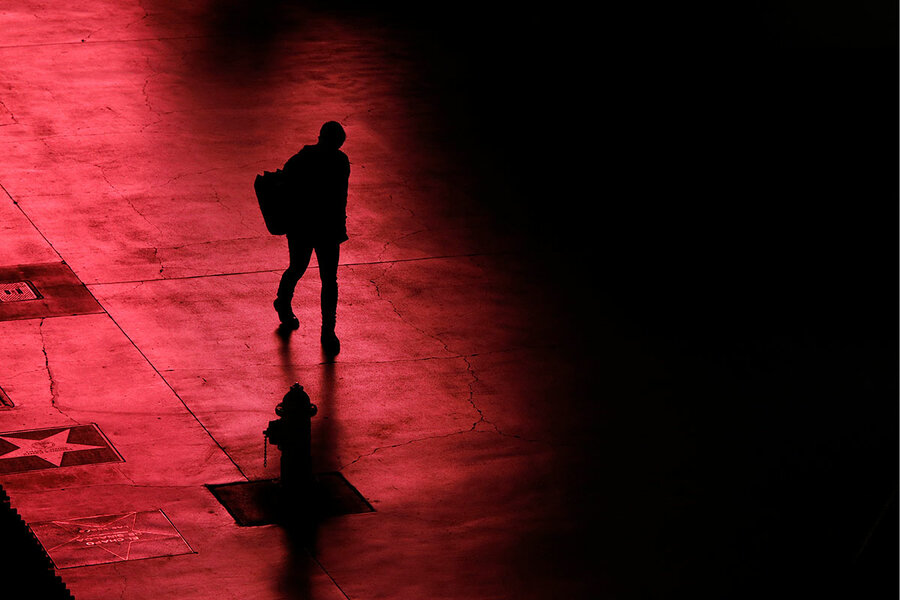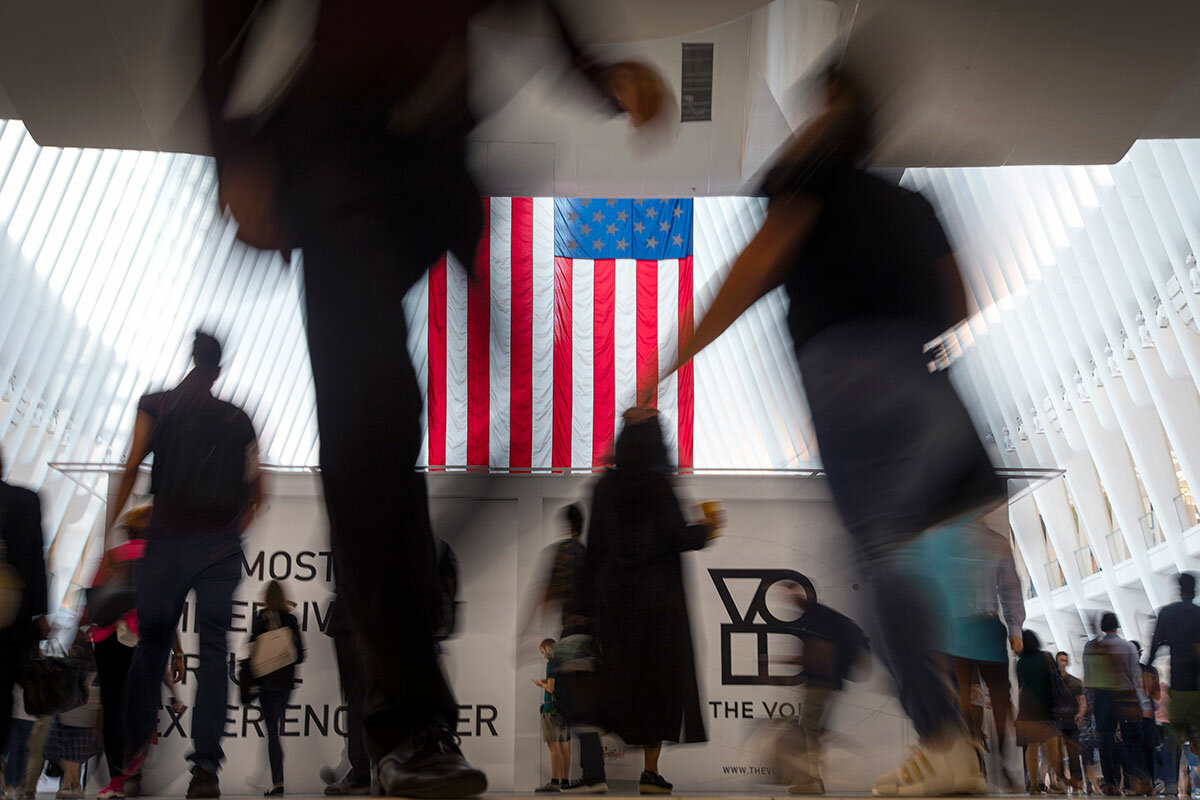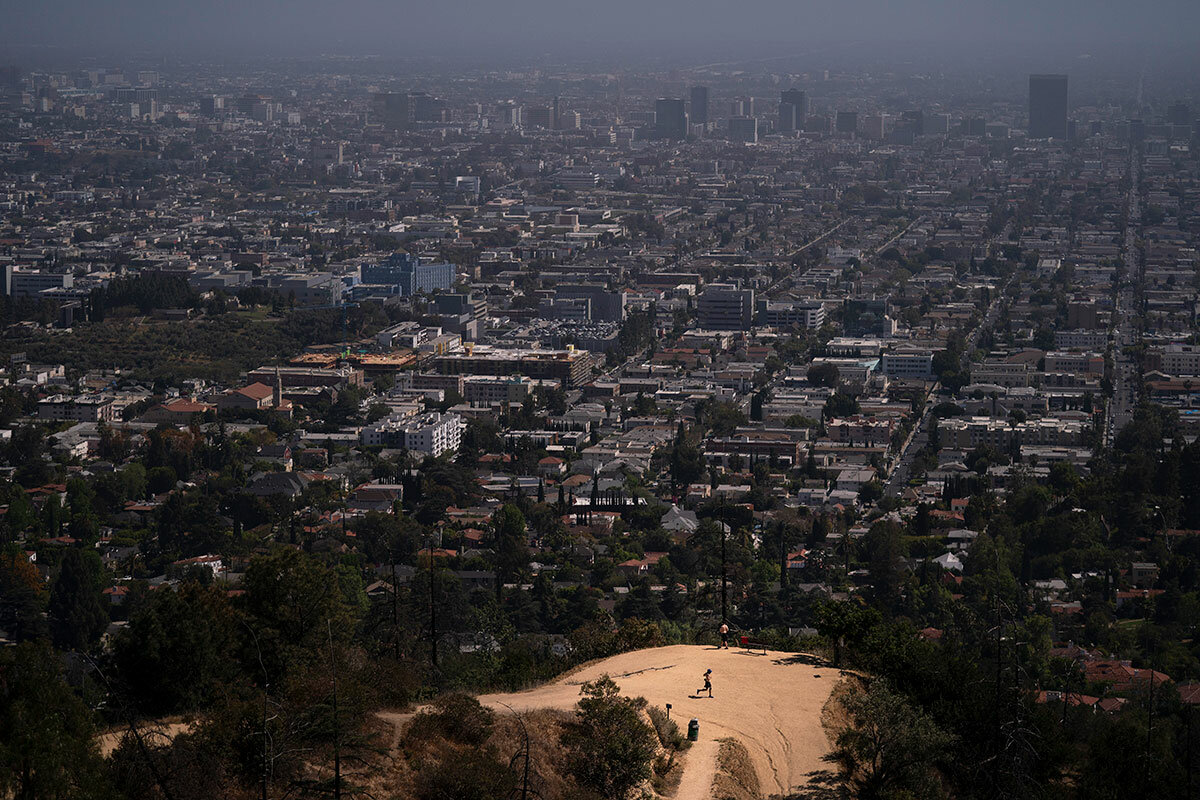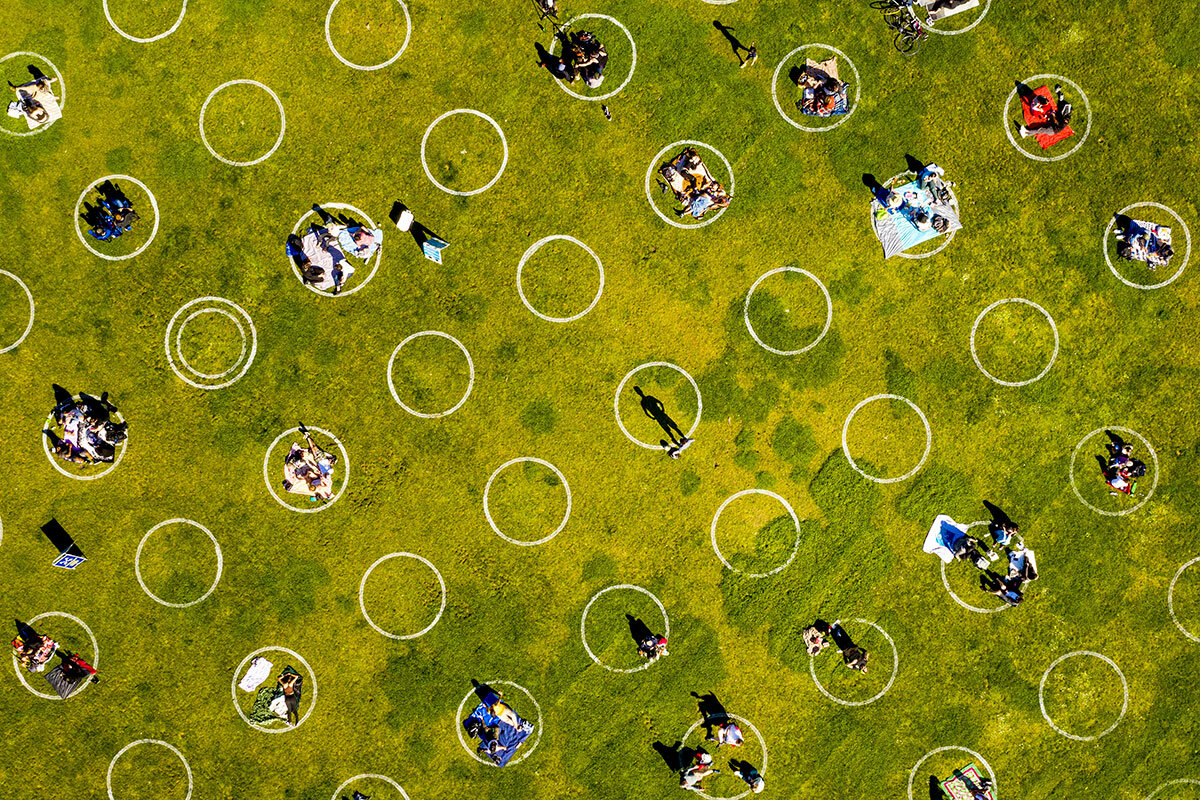One is the loneliest number: What will help people connect again?
Loading...
| New York and Washington
So many of the things that brought Emily Pipe joy before the pandemic have now just seemed to lose their spark.
She used to be a classic extrovert, says Ms. Pipe, a public school teacher in Delaware who works with preschoolers with disabilities. She’d charge her mental batteries with friends and social activities during the weekends and engage with colleagues at work, where there was a spirit of collaboration and common purpose.
“Now I’m at home on weekends, recharging my battery for work on Mondays,” says Ms. Pipe, who adds she’s seemed to become “fully introverted,” preferring to stay home and scroll through TikToks. And while teaching before the pandemic had its own challenges, they didn’t compare with those she experienced during the shutdown and ever since.
Why We Wrote This
A story focused onMany Americans are struggling to rediscover their spirit of community and connection after a pandemic that left behind an epidemic of loneliness.
Now, being in the classroom “is lonely,” says Ms. Pipe, who has been grappling with depression and anxiety. The spirit of collaboration at work has been replaced by a sense of isolation from other teachers. Students remain disoriented and distracted, and school administrators, she says, have not quite grasped the needs of the post-pandemic classroom or provided the support teachers like her now need.
The life changes worry her. And, she wonders, is she losing both her friends and her attention span?
In some ways, there’s a wide swath of Americans who have been feeling as if they’ve been in a proverbial funk since the pandemic wound down. For many, its disruptions have altered not only their daily rhythms but also their emotional equilibrium, even if a sense of crisis and instability has waned.
Michael Klein, a clinical psychologist in Massachusetts who works as a business consultant, remembers the creative energies he felt in the local coffee shop before the pandemic. That’s where he wrote most of his book on the challenges of running a family-owned business.
“It just hasn’t quite returned for me – that kind of creative spirit I used to find in places like these,” says Dr. Klein. “I think there’s also this very odd combination of we go to something communal, but we’re really anxious to be together.”
Dr. Klein, who coaches businesses on how to manage more cohesive teams of employees, thinks that while people are out and about more, many are still reckoning with the aftereffects of the pandemic years.
“COVID kind of ended with a whimper, and I don’t think we’ve quite processed the trauma of it all, even though it was this incredibly communal experience in a weird way,” says Dr. Klein. “I mean, worldwide we were going through the same kind of panic and fear and anxiety and uncertainty, but we knew we weren’t alone.”
“Now we’re left with, OK, so now what?” he says. “All of the sudden, it’s, OK, back to work, back to normal. So I think it’s appropriate to say, what’s going on? We’re all kind of feeling that we’ve been through this major traumatic event where millions of lives were lost, we’re more divided than ever, and we don’t really know what to go back to, since we can’t quite go back to life as it was.”
Disrupted sense of belonging
Much of what people are feeling may simply be part of natural emotional responses to life’s inevitable vicissitudes, both personal and professional, an extended case of inward-turning blues.
But there are deeper fears as well as the nation’s political divisions reach Manichean proportions, disputes among neighbors become cause for deadly gun violence, and even turning into the wrong driveway or ringing a doorbell has proved dangerous.
Such anecdotes, too, are then highlighted in the swirl of digital information in our ever-present screens, making many Americans, feeling besieged with mistrust and fear, become more and more wary of those around them.
“What we’ve been seeing with the kinds of rising narratives and around division and divisiveness is a challenge,” says Kim Serrano, director of the Center for Inclusion and Belonging at the American Immigration Council in Washington, D.C. “There’s been an intense focus on what sets us apart.”
This intense focus has disrupted what Ms. Serrano and her colleagues identify as a sense of belonging. In March, her center and the nonprofit Over Zero, which works to counteract identity-based violence, released a new study that found a wide majority of Americans say they don’t feel that they belong within their various social arenas. This includes 74% who say they don’t feel they belong in their local communities, and 64% who say the same of their places of work.
There can be a lot of ambiguity within concepts like belonging, however, and their “belonging barometer” measures a range of emotional experiences, Ms. Serrano says. “When we’re thinking about finding belonging, it’s not like a light switch, you know. It’s not like you just feel it or you don’t. There’s actually a lot of people who are experiencing uncertainty and ambiguity, so it’s really more of a spectrum.”
At the more serious end of the spectrum, medical experts have reported that there is a deeper kind of emotional malaise many Americans are experiencing, and they describe it as a growing “epidemic of loneliness and isolation” within the country.
In May, U.S. Surgeon General Vivek Murthy released a report on this national epidemic, which preceded the pandemic but was then exacerbated by it.
In the 2023 report, Dr. Murthy describes how he embarked on a cross-country listening tour during his first tenure in this position in 2014, when he says he didn’t view loneliness as much of a public health concern.
“I heard stories from my fellow Americans that surprised me,” he writes. “People began to tell me they felt isolated, invisible, and insignificant. Even when they couldn’t put their finger on the word ‘lonely,’ time and time again, people of all ages and socioeconomic backgrounds, from every corner of the country, would tell me, ‘I have to shoulder all of life’s burdens by myself,’ or ‘if I disappear tomorrow, no one will even notice.’”
The effects of these emotions have a direct impact on people’s physical health, the report found, including greater risks for disease, impaired cognitive functions, or suicide and self-harm.
The most effective solutions to the epidemic of loneliness and isolation, however, are what his report emphasizes as “the healing effects of social connection and community.”
“We are called to build a movement to mend the social fabric of our nation,” Dr. Murthy writes, adding that “it will take all of us” working together.
“Our individual relationships are an untapped resource – a source of healing hiding in plain sight,” he says.
“I’ve been sort of saying this is a problem for quite a long time,” says Darcia Narvaez, professor emerita of psychology at the University of Notre Dame. “So the report wasn’t a surprise to me. It was great to see that the government is paying attention to it. And it’s interesting, the report had such a pastoral tone, right? Yeah, it’s calling us back to our human nature. What helps us thrive is relationships, right? And connectedness. Feeling like we belong, like we matter, like we have something to contribute to the social community.”
The challenge is how, however. Dr. Narvaez, an expert in child development and parenting, brings an indigenous or kinship worldview to her studies, and she’s found that as early as childbirth, American social practices like separating infants from their mothers immediately after birth, a disconnection from the natural world, and a relentless focus on capitalist production has in various ways helped create a lonely society.
The epidemic of loneliness and isolation, too, is often borne unequally among economic and racial groups, says Jeffrey Gardere, associate professor of psychology and behavioral medicine at Touro University in New York.
During the pandemic, professionals and office workers were mostly able to transition to working from home, while essential workers, mostly lower-paid members of the working class and including higher proportions of Blacks and Latinos, experienced the dangers and disruptions of COVID-19 in a more significant way – just as they are within the ongoing epidemic of loneliness and isolation.
The traumas experienced by those more economically secure are different in many ways, and some of the phenomena of Americans turning inward are privileged, even if the emotional difficulties are real.
“We really need to be careful – and I found that with myself – that in our solitude and our comfort and our kind of detaching a little bit from society, being able to have that respite, that alone time to reevaluate our lives, that we don’t go too far with that,” says Dr. Gardere. Like many professionals in New York, he found a house in the country in Connecticut while maintaining an apartment in Manhattan, where he’s lived most of his life.
There’s a risk “where we begin to forget or lose the skills of being with other people, or start getting really anxious when it comes to being with others and connecting back in society with friends and at gatherings,” he says. “Those things are very important. They’re almost like booster shots to keep us healthy emotionally as we live this sort of hybrid life.”
“Keys to human connection are simple”
Hannah Schlomann, a program analyst whose firm works closely with the Department of Homeland Security in Washington, says while she was able to work pretty seamlessly at home during the pandemic, she found it difficult to reconnect with people in the same way as before.
“I spent so much time on Zoom, I’ve kind of forgotten how to do eye contact with people,” says Ms. Schlomann, who still works full time from her high-rise apartment in Washington. “Yeah, because you don’t look anyone in the eye anymore. And so I found that I had to kind of retrain myself once we started getting back into activities, and say, no, you need to look at that person and actually, like, interact when you’re offline.”
Larry Watkins, a retired general contractor who lives most of the year in a small community near Lake Lure, North Carolina, says there’s been a discernible hunger to reconnect with neighbors in the remote development of about 1,500 people 25 miles from the nearest town.
A member of the community’s board of directors, Mr. Watkins began noticing that there was an increased demand for common spaces, so he decided to renovate a 980-square-foot storage room, cleaning it out and painting it, thinking it could meet the need for a space for people to socialize. Other members of the community quickly got wind of the project and started donating furniture, pendant lights, kitchen cabinets, even a stove and microwave.
Before the pandemic, community gatherings were never very large, says Mr. Watkins. “If we got 15 or 20 people that was a rousing success,” he says. During the “soft opening” for the renovated community space on St. Patrick’s Day, around 50 people attended, he says. “It was a complete cross section,” from retirees like him who have lived there for years to 30-somethings with families who had moved in just a couple months prior.
It is efforts like these that can help tap into the healing effects of social connection and community, according to Surgeon General Murthy.
“They can help us live healthier, more productive, and more fulfilled lives,” he writes. “Answer that phone call from a friend. Make time to share a meal. Listen without the distraction of your phone. Perform an act of service. Express yourself authentically. The keys to human connection are simple, but extraordinarily powerful.”








